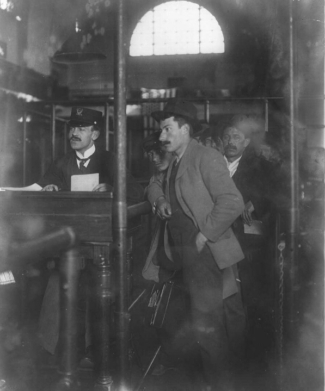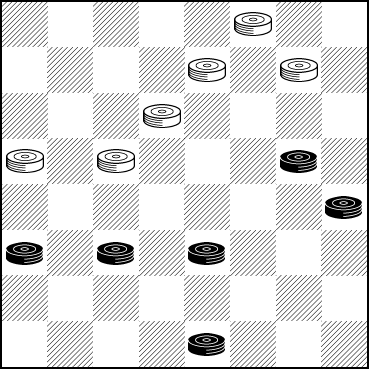Transcription Error?

We quickly found out that "Subkow" is one way to transcribe a Russian name that is sometimes rendered as "Zubkov" or "Zoubkov". Since the "S" and "Z" sounds are clearly delineated in Russian, we can only think that here is another story about fanciful transcriptions done by monolingual Anglophone immigration officials who just wanted to write something down and be done with it.
In any case, there are perhaps a half-dozen Subkows in the U.S., and it's quite likely that one or more are related to checkerist William Subkow, who is credited with the following problem circa 1930 or so. It's our Checker School entry for this month.
WHITE

BLACK
Black to Play and Draw
B:W30,26,25,23,20,19:B17,13,12,11,10,2.
You'll see right away that Black doesn't have much in the way of good moves; that's never a favorable sign. In fact, we'll give you a hint of sorts: There is only one initial move to draw, and that's no transcription error. The solution is a bit on the long side, but it's quite logical, although there are a couple of interesting ways to go wrong for both Black and White.
Can you find the right moves and transcribe them properly, in order to better check them after you click on Read More? That will take you to the solution, several sample games, and detailed explanatory notes.![]()
Solution
As is our custom, we have taken the main solution, sample games, lettered notes and other commentary from Ben Boland's classic Famous Positions in the Game of Checkers. Numbered notes are by the Editor using Ed Gilbert's KingsRow computer engine and 10-piece endgame database.
2-7---A, 1, 19-16---2, 12-19, 23-16, 11-15, 16-12, 17-21---B, 12-8---C, 10-14, 20-16---D, 7-10, 8-3, 14-18, 3-7, 10-14, 7-11, 15-19, 11-15, 19-24, 15-22, 14-17, 16-11, 24-28---4, 11-7, 28-32, 7-2, 32-28, 2-7, 28-24---5, 7-11, 24-28, 11-15, 28-24, 15-18, 24-28, 18-23, 28-24, 22-18---6, 17-22, 26-17, 13-29, 18-22---7, 24-28, 23-27, 28-32, 27-31, 32-28, 30-26---8, 21-25, 31-27, 25-30. Drawn---9.
Game: 11-15, 23-19, 9-14, 27-23, 5-9, 22-18, 15-22, 25-18, 7-11, 26-22, 11-16, 24-20, 3-7, 20-11, 8-24, 28-19, 4-8, 32-27, 8-11, 27-24, 1-5, 29-25, 9-13, 18-9, 5-14, 22-18, 13-17, 18-9, 6-13, 21-14, 10-17, 31-26, 7-10, 24-20. Forms above position. Wm. F. Ryan.
Game: 10-14, 22-18, 7-10, 2420, 9-13, 18-9, 5-14, 28-24, 11-15, 23-18, 15-22, 25-9, 1-5, 27-23, 5-14, 24-19, 8-11, 26-22, 11-15, 32-28, 15-24, 28-19, 3-7---S, 22-18, 14-17, 21-14, 10-17, 1815, 7-11, 15-8, 4-11, 29-25, 6-10, 31-26. Forms above position. A. J. Mantell.
Game: 9-13, 23-18, 6-9, 27-23, 1-6, 32-27, 11-15, 18-11, 8-15, 23-19, 7-11, 27-23, 9-14, 22-18, 15-22, 25-9, 5-14, 24-20, 11-15, 26-22, 15-24, 28-19, 3-7. Same as above at S. W. Subkow.
Game: 10-14, 23-18, 14-23, 26-19, 9-14, 27-23, 11-16, 32-27, 7-10, 24-20, 3-7, 20-11, 8-24, 28-19, 4-8, 22-18, 5-9, 25-22, 8-11, 27-24, 1-5, 29-25, 9-13, 18-9, 5-14, 2218, 13-17, 18-9, 6-13, 21-14, 10-17, 24-20, 7-10, 31-26. Forms above position. C. Hoare vs. J. A. Buchannan, up to third of the last move.
A---The only move, 11-15 loses by 20-16, 15-24, 25-21, 12-19, 21-7, 2-11, 23-7. White Wins. With White to Play: R. Martins, No. 11, Bohn's Handbook, 1850: 25-21, 17-22, 26-17, 13-22, 23-18, 2225, 18-14, 10-17, 21-14, 25-29, 14-9. White Wins. This finish may be found by Sturges, Anderson, Hay, Everrett, and Bowen.
B---If 15-18, 25-22, 18-25, 30-14, 10-17, 26-23, 17-22, 12-8, 22-26, 8-3, 7-10, 23-18, etc. White Wins.
C---26-23, 15-18---E, 23-14, 10-17, 12-8, 7-10, 8-3, 10-14, 3-7, 14-18, 7-10, 18-23, 10-14, this is now No. 90. American Checker Review, Vol. 4, 1892, by A. Sheean, continue, 2327, 20-16, 2731, 16-11, 31-27, 11-7, 27-23, 7-2, 23-27, 2-6, 27-32 (27-23 and 27-31 loses by 6-9 then 25-22), 6-10, 32-27, 14-9, 27-32, 10-15, 32-27, 15-19, 27-31, 9-14, 31-27, 14-18, 27-31, 18-23, 31-26,
25-22, 21-25, 30-14, 26-10. Drawn. O. V. Mills and B. Boland.
D---Crowning 8-3 permits 15-18, 3-17, 13-31. Black Wins---3. If 8-4, then 14-18, 4-8, 7-11. Draws. If 25-22, then 7-11, 8-3, 14-18, 3-7, 18-25, 7-16, 25-29, 16-11, 15-19, 11-15, 19-24, 15-18, 29-25, 26-23, 24-27, 23-19, 27-32, 19-15, 32-27, 15-10, 13-17. Drawn.
E---10-14, 25-22, 7-10, 128, 15-19. Draws. But 14-17 loses by 22-18, 15-22, 23-18. White Wins.
1---The win against 11-15 in Note A is quite flashy, but other Black moves lose more simply. 10-14 falls to 25-22 and then 22-18, as Black can't move 2-6 without allowing a 2 for 1 by 19-16.
2---The computer suggests 25-22 but it's a draw either way.
3---8-3 15-18 3x17 13x31 20-16 31-27 16-11 18-23 11-7 23-26 30x23 27x18. A nice Black win.
4---White is in a jam; he can't move his king without giving up a 2 for 1.
5---Black marks time while White looks for a solution.
6---White gives in and allows the shot.
7---Now it's Black's turn to be hemmed in, but forces are even and there is nothing White can do to Black's king in the double corner.
8---Another vain attempt to gain advantage.
9---It will be 3 kings vs. 3 kings with no edge on either side. A very nice study.
The above position was first published by N. W. Banks in his "Checkerist," Feb. 1925. The White Man on 20 on 24, with the caption, "White to Move and Win." Banks arrived at this setting in a blindfold, second double corner game. He invited readers solutions. All were White Wins. William Subkow arrived at the position, with A. I. Mantell in crossboard consultation. It was later published in the Mt. Sterling (Kentucky) Advocate, from Aug. 3, 1937 to Jan. 11, 1938. Willie Ryan was writing his "Championship Checkers Simplified," at this time, the writer gave him above information.
You can email the Webmaster with comments on this article.